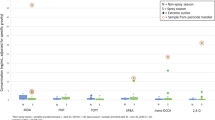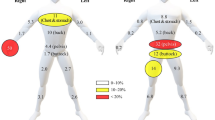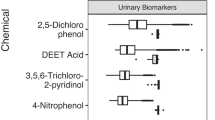Abstract
We estimated cumulative residential pesticide exposures for a group of nine young children (4–6 years) using three different methodologies developed by the US Environmental Protection Agency and compared the results with estimates derived from measured urinary metabolite concentrations. The Standard Operating Procedures (SOPs) for Residential Exposure Assessment are intended to provide a screening-level assessment to estimate exposure for regulatory purposes. Nonetheless, dermal exposure estimates were typically lower from the SOP (1–1300 nmol/day) than from SHEDS (5–19,000 nmol/day) or any of the four different approaches for estimating dermal exposure using the Draft Protocol for Measuring Children's Non-Occupational Exposure to Pesticides by all Relevant Pathways (Draft Protocol) (5–11,000 nmol/day). Indirect ingestion exposure estimates ranged from 0.02 to 21.5 nmol/day for the SOP, 0.5 to 188 nmol/day for SHEDS, and 0 to 3.38 nmol/day for the Draft Protocol. Estimates of total absorbed dose ranged from 3 to 37 nmol/day for the SOPs, 0.5 to 100 nmol/day for SHEDS, and 1 to 216 nmol/day for the Draft Protocol. The concentrations estimated using the Draft Protocol and SHEDS showed strong, positive relationships with the 3-phenoxybenzoic acid metabolite measured in the children's urine samples (R2=0.90 for the Draft Protocol; R2=0.92 for SHEDS). Analysis of different approaches for estimating dermal exposure suggested that the approach assuming an even distribution of pesticide residue on the child's body was most reasonable. With all three methodologies providing reasonable estimates of exposure and dose, selection should depend on the available data and the objectives of the analysis. Further research would be useful to better understand how best to estimate dermal exposure for children and what exposure factors (e.g., activities, transfer coefficients, measurement techniques) are most relevant in making dermal exposure estimates.
This is a preview of subscription content, access via your institution
Access options
Subscribe to this journal
Receive 6 print issues and online access
$259.00 per year
only $43.17 per issue
Buy this article
- Purchase on Springer Link
- Instant access to full article PDF
Prices may be subject to local taxes which are calculated during checkout


Similar content being viewed by others
References
Boobis A.R., Ossendorp B.C., Banasiak U., Hamey P.Y., Sebestyen I., and Moretto A. Cumulative risk assessment of pesticide residues in food. Toxicol Lett 2008: 180 (2): 137–150.
Bradman A., Whitaker D., Quiros L., Castorina R., Henn B.C., Nishioka M., Morgan J., Barr D.B., Harnly M., Brisnin J.A., Sheldon L.S., McKone T.E., and Eskenazi B. Pesticides and their metabolites in the homes and urine of farmworker children living in the Salinas Valley, CA. J Expo Sci Environ Epidemiol 2007: 17 (4): 331–349.
Cohen Hubal E.A., Egeghy P.P., Leovic K.W., and Akland G.G. Measuring potential dermal transfer of a pesticide to children in a child care center. Environ Health Perspect 2006: 114 (2): 264–269.
Cohen Hubal E.A., Sheldon L.S., Burke J.M., McCurdy T.R., Berry M.R., Rigas M.L., Zartarian V.G., and Freeman N.C.G. Children's exposure assessment: a review of factors influencing children's exposure, and the data available to characterize and assess that exposure. Environ Health Perspect 2000a: 108 (6): 475–486.
Cohen Hubal E.A., Sheldon L.S., Zufall M.J., Burke J.M., and Thomas K.T. The challenge of assessing children's residential exposure to pesticides. J Expo Anal Environ Epidemiol 2000b: 10: 638–649.
Eadsforth C.V., and Baldwin M.K. Human dose-excretion studies with the pyrethroid insecticide, cypermethrin. Xenobiotica 1983: 13 (2): 67–72.
Eadsforth C.V., Bragt P.C., and van Sittert N.J. Human dose-excretion studies with pyrethroid insecticides cypermethrin and alphacypermethrin: relevance for biological monitoring. Xenobiotica 1988: 18 (5): 603–614.
Fenske R.A., Lu C., Curtl C.L., Shirai J.H., and Kissel J.C. Biologic monitoring to characterize organophosphorus pesticide exposure among children and workers: an analysis of recent studies in Washington State. Environ Health Perspect 2005: 113 (11): 1651–1657.
Hore P. Pesticide Accumulation Patterns for Child Accessible Surfaces and Objects and Urinary Metabolite Excretion by Children for Two Weeks after a Professional Crack and Crevice Application. Doctoral dissertation submitted to Rutgers, State University of New Jersey and the University of Medicine and Dentistry of New Jersey, School of Public Health, 2003.
Leng G., Leng A., Kuhn K.-H., Lewalter J., and Pauluhn J. Human dose-excretion studies with the pyrethroid insecticide cyfluthrin: urinary metabolite profile following inhalation. Xenobiotica 1997: 27 (12): 1273–1283.
Lu C., Toepel K., Irish R., Fenske R.A., Barr D.B., and Bravo R. Organic diets significantly lower children's dietary exposure to organophosphorus pesticides. Environ Health Perspect 2006: 114 (2): 260–263.
Morgan M.K., Sheldon L.S., Croghan C.W., Jones P.A., Robertson G.L., Chuang J.C., Wilson N.K., and Lyu C.W. Exposures of preschool children to chlorpyrifos and its degradation product 3,5,6-trichloro-2-pyridinol in their everyday environments. J Expo Anal Environ Epidemiol 2005: 15 (4): 297–309.
Naeher L.P., Tulve N.S., Egeghy P.P., Barr D.B., Adetona O., Fortmann R.C., Needham L.L., Bozeman E., Hilliard A., and Sheldon L.S. Organophosphorus and pyrethroid insecticide urinary metabolite concentrations in young children living in a southeastern United States city. Sci Total Environ 2010: 408 (5): 1145–1153.
Ogden C.L., Kuczmarski R.J., Flegal K.M., Mei Z., Guo S., Wei R., Grummer-Strawn L.M., Curtin L.R., Roche A.F., and Johnson C.L. Centers for Disease Control and Prevention 2000 growth charts for the United States: improvements to the 1977 National Center for Health Statistics version. Pediatrics 2002: 109 (1): 45–60.
Tulve N.S., Egeghy P.P., Fortmann R.C., Whitaker D.A., Nishioka M.G., Naeher L.P., and Hilliard A. Multimedia measurements and activity patterns in an observational pilot study of nine young children. J Expo Sci Environ Epidemiol 2008: 18 (1): 31–44.
Tulve N.S., Jones P.A., Nishioka M., Fortmann R.C., Croghan C.W., Zhou J.Y., Fraser A., Cave C., and Friedman W. Pesticide measurements from the first national environmental health survey of child care centers using a multi-residue GC/MS analysis method. Environ Sci Technol 2006: 40 (20): 6269–6274.
Tulve N.S., Suggs J.C., McCurdy T., Cohen Hubal E.A., and Moya J. Frequency of mouthing behavior in young children. J Expo Anal Environ Epidemiol 2002: 12 (4): 259–264.
US EPA. 2002. Child-Specific Exposure Factors Handbook. Office of Research and Development, National Center for Environmental Assessment, Washington, DC. EPA/600/P-00-002B. (http://cfpub.epa.gov/ncea/cfm/recordisplay.cfm?deid=55145).
US EPA. 2001. Draft Protocol for Measuring Children's Non-Occupational Exposure to Pesticides by all Relevant Pathways. Office of Research and Development, Research Triangle Park. NC EPA/600/R-03/026. (http://nepis.epa.gov/).
US EPA. 1999. Overview of Issues Related to the Standard Operating Procedures for Residential Exposure Assessment. United States Environmental Protection Agency, Office of Pesticide Programs, Washington, DC. ( http://www.epa.gov/scipoly/sap/meetings/1999/september/resid.pdf).
US EPA. 2009. Reregistration Eligibility Decision (RED) for Permethrin. United States Environmental Protection Agency, Prevention, Pesticides and Toxic Substances, Washington, DC. EPA/738-R-09-306. ( http://www.afpmb.org/bulletin/vol29/permethrin-red-revised-may20091.pdf).
US EPA. 1997. Standard Operating Procedures (SOPs) for Residential Exposure Assessments. Office of Pesticide Programs, Health Effects Division, Washington, DC. (http://www.epa.gov/scipoly/sap/meetings/1997/september/sopindex.htm). (Interim update: US EPA. 2000. Part B – SOPs. Residential SOPs. Washington, DC: Office of Pesticide Programs, Health Effects Division. Jeff Evans).
Whyatt R.M., Rauh V., Barr D.B., Camann D.E., Andrews H.F., Garfinkel R., Hoepner L.A., Diaz D., Dietrich J., Reyes A., Tang D., Kinney P.L., and Perera F.P. Prenatal insecticide exposures and birth weight and length among an urban minority cohort. Environ Health Perspect 2004: 112 (10): 1125–1132.
Wilkinson C.F., Christoph G.R., Julien E., Kelley J.M., Kronenberg J., McCarthy J., and Reiss R. Assessing the risks of exposures to multiple chemicals with a common mechanism of toxicity: how to accumulate? Regul Toxicol Pharmacol 2000: 31 (1): 30–43.
Woollen B.H., Marsh J.R., Laird W.J.D., and Lesser J.E. The metabolism of cypermethrin in man: differences in urinary metabolite profiles following oral and dermal administration. Xenobiotica 1992: 22 (8): 983–991.
Xue J., Zartarian V., Moya J., Freeman N., Beamer P., Black K., Tulve N., and Shalat S. A meta-analysis of children's hand-to-mouth frequency data for estimating nondietary ingestion exposure. Risk Anal 2007: 27 (2): 411–420.
Xue J., Zartarian V., Ozkaynak H., Dang W., Glen G., Smith L., and Stallings C. A probabilistic arsenic exposure assessment for children who contact chromated copper arsenate (CCA)-treated playsets and decks, part 2: sensitivity and uncertainty analyses. Risk Anal 2006: 26 (2): 533–541.
Zartarian V., Glen G., Smith L., and Xue J. SHEDS-Multimedia Model Version 3 Technical Manual. September 2008 http://www.epa.gov/heasd/risk/projects/c1b_exposure_models_development.htm, 2008.
Zartarian V.G., Ozkaynak H., Burke J.M., Zufall M.J., Rigas M.L., and Furtaw Jr E.J. A modeling framework for estimating children's residential exposure and dose to chlorpyrifos via dermal residue contact and nondietary ingestion. Environ Health Perspect 2000: 108 (6): 505–514.
Zartarian V.G., Xue J., Ozkaynak H., Dang W., Glen G., Smith L., and Stallings C. A probabilistic arsenic exposure assessment for children who contact CCA-treated playsets and decks, part 1: model methodology, variability results, and model evaluation. Risk Anal 2006: 26 (2): 515–531.
Acknowledgements
The United States Environmental Protection Agency through its Office of Research and Development partially funded and collaborated in the research described here under contract number 68-D-99-011 to Battelle Memorial Institute. It has been subjected to Agency administrative review and approved for publication. Mention of trade names or commercial products does not constitute endorsement or recommendation for use. We thank the parents and children for their participation, the staff of the Lead Division at the DCHD for logistical support, and the laboratory staffs at Battelle and CDC for their analytical support.
Author information
Authors and Affiliations
Corresponding author
Ethics declarations
Competing interests
The authors declare no conflict of interest.
Additional information
Supplementary Information accompanies the paper on the Journal of Exposure Science and Environmental Epidemiology website
Supplementary information
Rights and permissions
About this article
Cite this article
Tulve, N., Egeghy, P., Fortmann, R. et al. Methodologies for estimating cumulative human exposures to current-use pyrethroid pesticides. J Expo Sci Environ Epidemiol 21, 317–327 (2011). https://doi.org/10.1038/jes.2010.25
Received:
Accepted:
Published:
Issue Date:
DOI: https://doi.org/10.1038/jes.2010.25
Keywords
This article is cited by
-
Pyrethroid exposure among children residing in green versus non-green multi-family, low-income housing
Journal of Exposure Science & Environmental Epidemiology (2021)
-
Persistence of indoor permethrin and estimation of dermal and non-dietary exposure
Journal of Exposure Science & Environmental Epidemiology (2020)
-
Pyrethroid levels in toddlers’ breathing zone following a simulated indoor pesticide spray
Journal of Exposure Science & Environmental Epidemiology (2019)
-
Mouthing activity data for children age 3 to <6 years old and fraction of hand area mouthed for children age <6 years old in Taiwan
Journal of Exposure Science & Environmental Epidemiology (2018)
-
Mouthing activity data for children aged 7 to 35 months in Taiwan
Journal of Exposure Science & Environmental Epidemiology (2015)



